
Actualize Energetic Life by Creating Brain Information Industries
Program Manager
Yoshinori Yamakawa
Yoshinori Yamakawa
2000 M.S., Graduate School of Science, Kyoto University
2000 ‒ 2005 NEC Corporation
2008 Received Ph.D. from the Graduate School of Human and Environmental Studies, Kyoto University (Human and Environmental Studies)
2008-2010 GCOE Assistant Professor, Graduate School of Informatics, Kyoto University
2010 – Director, Neuro Innovation Unit, NTT Data Institute of Management Consulting, Inc.
Part-time instructor, Graduate School of Management, Kyoto University
Part-time instructor, Research Institute for Economics & Business Administration, Kobe University
2014- ImPACT Program Manager (Effort: 100%)
(Transferred to JST from NTT Data Institute of Management Consulting)
2000 ‒ 2005 NEC Corporation
2008 Received Ph.D. from the Graduate School of Human and Environmental Studies, Kyoto University (Human and Environmental Studies)
2008-2010 GCOE Assistant Professor, Graduate School of Informatics, Kyoto University
2010 – Director, Neuro Innovation Unit, NTT Data Institute of Management Consulting, Inc.
Part-time instructor, Graduate School of Management, Kyoto University
Part-time instructor, Research Institute for Economics & Business Administration, Kobe University
2014- ImPACT Program Manager (Effort: 100%)
(Transferred to JST from NTT Data Institute of Management Consulting)
Profile
Yamakawa acquired multifarious perspectives and networks through neuroscience studies in the university, and through industrial experiences.
Yamakawa acquired multifarious perspectives and networks through neuroscience studies in the university, and through industrial experiences.
What's New
2017/10/20[Press Release]
Overview
Almost all of the unresolved social challenges that we face today are associated with neurological and psychological issues. These include the need for information technologies that can communicate user’s feelings in an information society, acquisition of professional expertise needed in a service economy, the prevention of a decline in brain functions in a rapidly aging society and so on. Needed are innovative efforts to use neuroscience to link the visualization of brain information and research into control technologies to the resolution of social issues. This program will make service models for brain information in the three sectors of health, education and information science publicly available. The construction of an innovation ecosystem through the creation of a brain information infrastructure will create the world’s first brain information industries and achieve energetic lifestyles. 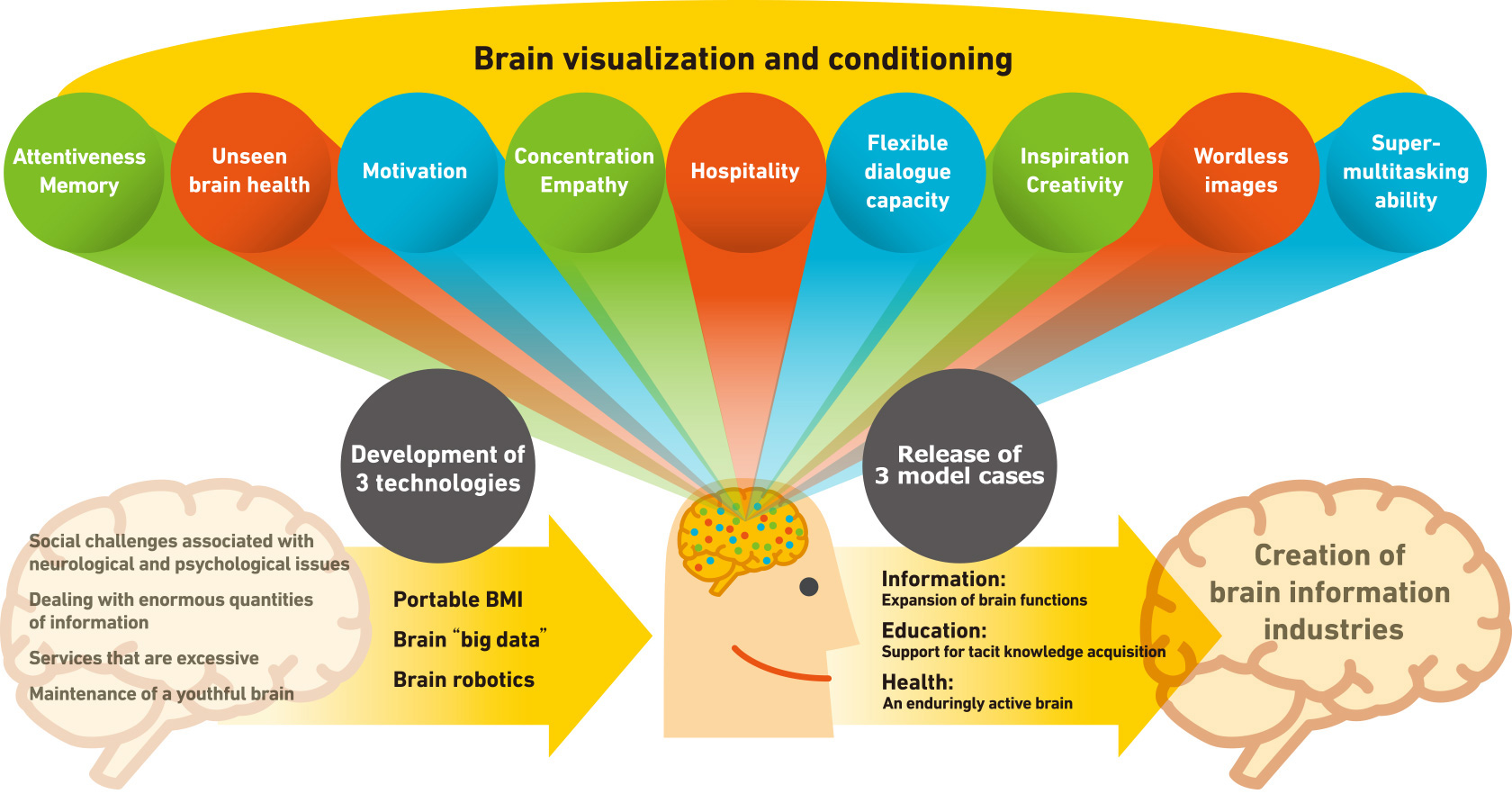

Disruptive Innovation
Keys to breakthrough
- Brain information is widely used in medical and R&D field, however, there are barriers to overcome toward commercialization.
- Define model cases of commercialization, and create “innovation ecosystem” for interdisciplinary researchers and industries to cooperate which lead to breakthroughs.
- Reduce brain information acquisition costs to 1/10, and improve performance tenfold.
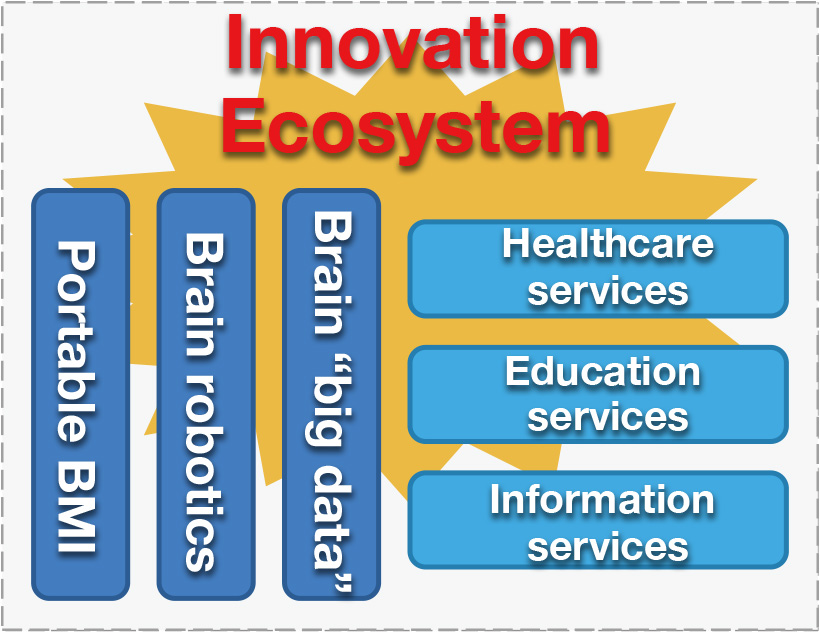
The Challenges for the PM and the Impact of Success
Overview and background
- Many social challenges are associated with neurological and psychological issues. For example, aging society accompanies declining brain functions, service-oriented economy requires professional expertise, and IT services which can communicate users' feelings to further develop information-oriented society.
- To tackle these challenges, it will be critical to introduce socially acceptable technologies including brain big data and brain robotics for advanced information use, having a portable brain machine interface (BMI) as a central technology which anyone is able to visualize and control his/her own brain information.
Impact on industry and society in the event of achievement
- While Europe and U.S. primarily focus on medical fields, this program will try its best to overcome the social challenges through commercializing the technologies developed within the program. As a result, Japan will be the first to create brain information industry, and actualize energetic life.
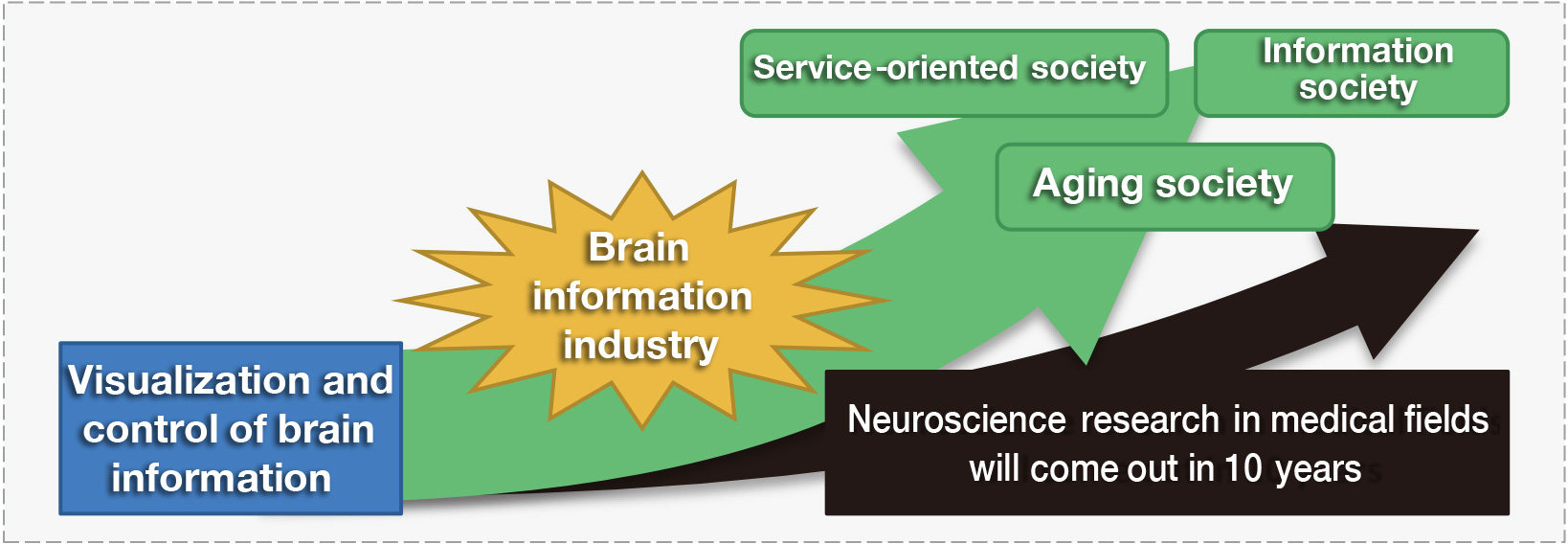
Scenario for Success and Achievement Targets
Methods of resolution for success (Approach)
- Promote research and development of three brain information application technologies (Portable BMI, Brain Big Data, and Brain Robotics) for unveiling three example models (Health: An enduringly active brain; Education: Support for tacit knowledge acquisition; Information: Expansion of brain functions).
- Create innovation ecosystems through establishment of brain information infrastructure, including common clouds, common fields, standardization and ethics) which enable timely hypothesis verifications.
Management strategies
- Establish nine R&D groups of technologies and services.
- 30% of the total budget from each research group will be solicited through open competitive procedures to explore wide-ranging new research possibilities. In addition, by setting "stage gates" and reviewing every 1.5 years, 30% of budgets will be allocated depending on achievements.
- Establish multiple financing schemes to raise funds from external resources in order to accelerate R&D and commercialization.
Achievement targets
- The ultimate goals are to introduce model cases and to create ecosystems.
- The technical goal is to reduce the cost to 1/10, and improve performance tenfold.
- The service goals are to launch brain venture companies, provide solutions through industry-academia collaborations, create forums, and achieve sustainable organizations.
Risks
- Strong commitments are required from all participating entities to set and purse high-risk and high-payoff goals.
- In addition to ethical issues, concerns may arise from stakeholders during establishment of ecosystems.
Overall R&D Program Structure Created by the PM
- A project structure with nine clearly established example models of brain information utilization and application.
- With Portable BMI at the core, execute collaborative R&D between Brain Big Data and Brain Robotics.
- Establish a funding scheme aligned with the topic and progress of the R&D and tangibly achieve both accelerated R&D and advancement of social implementation.
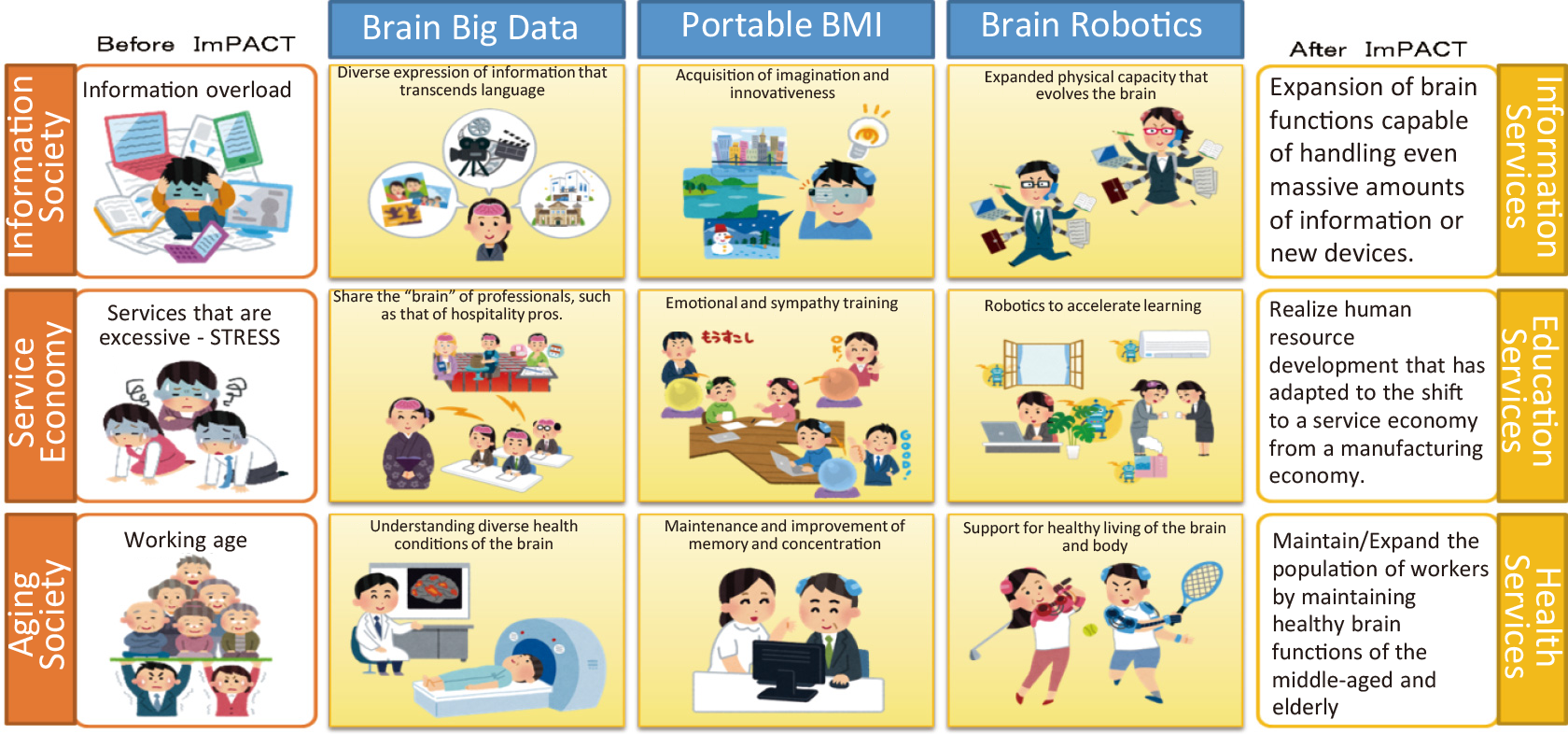
Implementation Structure as Assembled by the PM
Keys of the implementation structure
- Based on the left matrix, 9 R&D groups will be established as modules including technologies (portable BMI, brain big data, and brain robotics) and services (health, education, and information). A general technical officer will be appointed for each technical module.
- The research activities of brain information infrastructure include common clouds, common fields, standardization and ethical issues. In addition, conduct reviews of business models and liaise with external organizations as a brain information management.
Approach to selection of institutions
- To introduce model cases, institutions already have R&D capabilities will be considered.
- During the selection process, in addition to research achievements, availability of research facilities for this program, willingness to start venture companies, and openness to collaborations are plus.
- Main research institutions that fulfill the above requirements will be assigned as shown in the left figure.
- 30% of the entire budget will be allocated through open competitive procedures. Expecting responses for solicitations from young researchers with innovative ideas, researches from any fields, and private corporations.
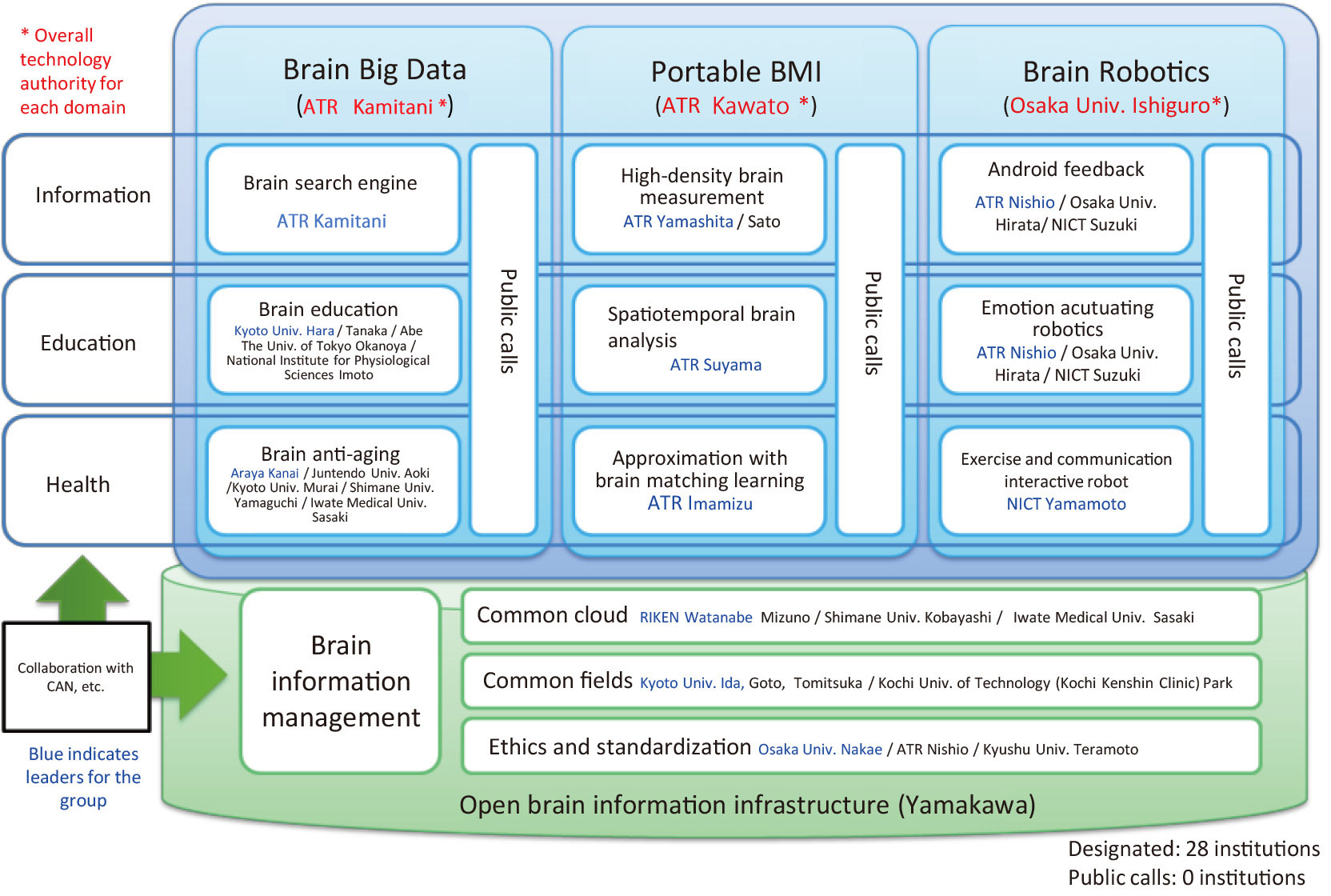
Organization
The Cabinet Office
ImPACT: Impulsing Paradigm Change through Disruptive Technologies Program
ImPACT Program Manager
Yoshinori Yamakawa
ImPACT: Impulsing Paradigm Change through Disruptive Technologies Program
ImPACT Program Manager
Yoshinori Yamakawa
Associate Program Manager
Hiroki Oka
Hiroki Oka
Associate Program Manager
Hiroki Fukuda
Hiroki Fukuda
Associate Program Manager
Hiromu Soukawa
Hiromu Soukawa
Associate Program Manager
Hiroshi Yasuda
Hiroshi Yasuda
Associate Program Manager
Masahiro Yamamoto
Masahiro Yamamoto

